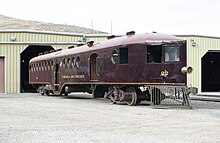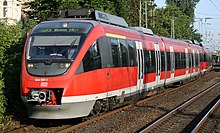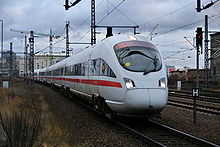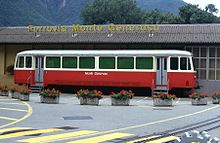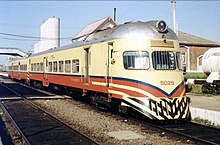Combustion railcars
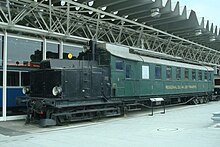


Railcars and Verbrennungsstriebzüge are railway vehicles with internal combustion engine , which unlike locomotives as railcars accommodate passengers or goods themselves. In the history of these vehicles there were different types of drive and fuel, the current combustion railcars, on the other hand, are operated almost exclusively with diesel fuel. This fact resulted in the designation "diesel multiple unit", which was widespread in Germany, as well as the series identification of German vehicles with the prefix "VT" until the 1960s.
history
Beginnings
In order to be able to operate routes with little traffic economically, steam railcars began to be built in the middle of the 19th century , whose use was always limited to relatively short routes due to their limited water and coal supplies. More practical solutions arose from the development of internal combustion engines.
The five petrol railcars BW 1–5 of the Royal Württemberg State Railways with mechanical power transmission, built from 1887 to 1900 by the Esslingen machine factory with Daimler engines, can be regarded as the first combustion railcars . Because of their low engine power of 25-30 HP, the railcars were only suitable for light operations. Also because of the gearbox they didn't prove themselves and were replaced by steam railcars after a few years. A sixth structurally identical vehicle was sold to the Swiss Northeast Railway in 1900 and from there to the SBB.

At the beginning of the 20th century, the first larger series of combustion railcars were developed and built in North America from 1905 and in Europe from 1906. The Weitzer János company from Arad built the Weitzer-De Dion-Bouton railcars for the Aradi és Csanádi Egyesält Vasutak (ACsEV) and other Hungarian railway companies on a trial basis from 1903 and in series from 1906 . The four-cylinder engines came from the French vehicle manufacturer De Dion-Bouton , who had developed the petrol-electric drive used in the railcar as early as 1899/1900 for a passenger car by Henry Pieper . In 1910, the ACsEV owned 41 of these railcars. Additional railcars were built for other Hungarian private railways and in 1907 two for the Romanian State Railways . The American pioneer in the building of motorized railcars was William McKeen, an engineer with the Union Pacific Railroad . With the support of his previous employer, he went into business for himself and began producing streamlined railcars in Omaha in the US state of Nebraska from 1905 , the engines and transmissions of which were derived from ship drives. 152 of these McKeen railcars were built there from 1905 to 1917 and sold to over 40 US and four foreign railroad companies.

On the eve of the First World War , the Royal Saxon State Railways put the world's first two fully functional diesel-electric railcars into service. DET 1 u. 2 . The war interrupted the promising development. Eventually the railcars made it to Switzerland, where they were in service for about twenty years. In 1914, the Otavi Mining and Railway Company in the colony of German South West Africa received a railcar with a DMG engine for a track width of 600 mm, which reached a top speed of 138 km / h.
In the 1920s, branch lines in many countries faced competition from motorized road traffic, which was countered with the use of railcars. After the First World War, AEG and Deutsche Werke Kiel (DWK) began manufacturing internal combustion railcars on the basis of aircraft and ship engines in Germany as part of the armaments conversion in the early 1920s, which were delivered to numerous private railways. The private railways took on a pioneering role in the use of combustion railcars in Germany; the Reichsbahn did not begin to build significant numbers until the 1930s. In France, the railcars of the car manufacturer De Dion-Bouton and Billard , Chatenay et Cie became known in the 1920s, and the rubber-tired Micheline railcars in the early 1930s.
In Austria, the Austro Daimler company, with its lightweight petrol multiple units, endeavored to transfer the construction principles of road vehicle construction to rail vehicle construction. Their Austro-Daimler railcars of the BBÖ series VT 61 , VT 62 and VT 63 had pneumatic tires running in railway wheels, as well as the latter for the first time with a hydraulic transmission developed jointly with Voith . Specially designed narrow-gauge railcars were also delivered to the Salzkammergut-Lokalbahn and the Styrian State Railways. All types were equipped with an 80 hp AD 640 six-cylinder petrol engine. Due to the ultra-lightweight construction and the gasoline engines used, the railcars ultimately proved to be too weak for rail operations and could not prevail. Most of them were withdrawn from circulation before 1939.
In Czechoslovakia, Tatra did pioneering work in the field of internal combustion engine railcars in Koprivnice. Your Tatra tower cars made a valuable contribution to the rationalization of traffic on branch lines.

Diesel multiple units in Germany
At the beginning of the 1930s, the Wismar rail buses (still powered by gasoline engines) were developed for low-cost passenger transport on branch lines . Initially, 29 two-axle railcars of the VT 135 series (numbers 002-059, with gaps) were purchased from the DRG . They received matching sidecars and were subsequently rebuilt several times. The successor type VT 135 (numbers 061–132) is already reminiscent of the rail buses of the post-war period with its round shape. In addition to the intention to save staff and protect the superstructure with light vehicles, attempts were also made early on to reduce planning and acquisition costs by adopting components from road vehicle construction . The engines from Ford for the Wismar rail buses are an example of this. With the post-war series VT 95 (DB, CFL ) and VT 2.09 (DR), this approach was initially consistently pursued, but with the VT 98 it was partly returned to the "classic" rail vehicle.
Wismar rail bus ,
built 1932–1941Uerdinger rail bus VT 95 ,
built 1950 / 1952–1958
After vehicles for local traffic, combustion railcars for long-distance and high-speed traffic were also developed and built. The VT 877 ( Fliegender Hamburger ) was the first diesel express railcar of the Deutsche Reichsbahn and at the same time the first streamlined train in scheduled use. From 1933 it was used to establish the world's fastest train connection between Berlin and Hamburg . However, due to the increasing shortage of diesel oil in the course of the Second World War , this development soon stalled.
After the Second World War, DB and DR as well as the NE railways took on the topic of diesel traction again. Several types of railcars were developed in the Federal Republic of Germany, such as the DB Uerdinger rail bus from 1950 onwards , which in its basic forms VT 95 and VT 98 became a “branch line saver” for many years. In the end, however, these railcars could not prevent the "withdrawal from the area". From 1951 the Esslingen railcar and 1955 the MAN railbus were produced for the NE railways . In 1957 the DR followed with the development of its rail buses of the VT 2.09 series .
The first multiple units, units of one or two multiple units with non-powered intermediate wagons (and / or possibly a control wagon ), were built for the main railways . Spectacular vehicles of the 1950s were the TEE trains of the VT 11.5 series , which were designed for high-quality cross-border traffic. They received a counterpart in the GDR with the VT 18 series . Diesel multiple units for regional traffic on main lines included the DB class 624 and its successor 614, which was originally developed for tilting technology . Towards the end of their period of service they migrated to subordinate services.
In view of the death of the branch line, the Deutsche Bundesbahn could not make up its mind for a long time to buy successors for the rail buses. A start was made in the 1970s with the 13 vehicles of the 627 series , which led to the 628 series, which was purchased in larger numbers . At the end of the 1980s, the 610 series, the first double railcars with curved track-dependent car body control (tilting technology) were ordered. This development culminated in the 200 km / h fast ICE TD multiple units, which, however, turned out to be problematic and are only used today without inclining bends.
In addition to the state-owned railway companies, private railroad companies also bought internal combustion engines. Here, stronger vehicles were often preferred to the Uerdingen railbus because they could pull freight cars, which promised to make the maintenance of freight locomotives superfluous. Since private railways have increasingly started offering traffic on the formerly state network , the number of diesel multiple units and their types has increased significantly.
With a few exceptions, Deutsche Bahn no longer uses locomotive-hauled passenger trains on branch lines.
Series
- Series of less than 10 cars or trains are only included in exceptional cases.
Germany
German small and private railways (until 1945)
- DWK model IV a standard gauge (1924); different societies; Manufacturer DWK
- AEG benzene railcar (1925); different companies and different manufacturers
- BHM T 279 (1928); Manufacturer Sächsische Waggonfabrik
- KWOe T1 and T2 (1933); OHE ; Manufacturer Gothaer Waggonfabrik
- RSE T1 ... T5 (1934); Bröltalbahn ; Manufacturer Waggonfabrik Wismar
- SEG T22 and T23 (1935); Southern German Railway Company ; Manufacturer MAN
- CSM T22 (1935); OHE ; Manufacturer Waggonfabrik Talbot
- Neukölln-Mittenwald Railway T1 (1936); Neukölln-Mittenwald Railway ; Manufacturer Christoph & Unmack
- RAG VT 01, VEE VT 101 (1938); different societies; Manufacturer Dessauer Waggonfabrik
- Weimar-Berka-Blankenhainer Railway T10 (1938); WBBE ; Manufacturer DUEWAG
- Butjadinger Bahn T 2 (1940); Manufacturer WUMAG
Deutsche Reichsbahn Gesellschaft and Deutsche Reichsbahn (until 1945)
- VT 133/135 (Wismar rail bus; at DB: VT 88.9)
- VT 10 ( freight railcar )
- Flying hamburger
- SVT 137
- VT 135 (first type)
- VT 135 (second type)
Deutsche Reichsbahn (1949–1993)
- VT 12 , express railcar, built in 1954
- VT 2.09 , "Ferkeltaxe", built 1957 / 1962–1969
- VT 18 , express railcar, built 1963 / 1965–1968
German Federal Railroad (1949–1993)
- Rail-road omnibus
- VT 95 (single-engine rail bus)
- VT 98 (twin-engine rail bus)
- VT 08
- VT 11.5 (TEE multiple unit)
- VT 12
- VT 24
- Series 614
- Series 628
- Series 610 ("Pendolino" with tilting technology)
Deutsche Bahn (from 1994)
- Class 611 , 1996/97, 50 two-part trains with tilting technology (2'B '+ B'2')
- Series 612 , 1998 ff., 192 two-part trains with tilting technology (2'B '+ B'2')
- Alstom Coradia LINT (series 620, 622, 623, 640, 648 and 1648)
- Series 650 , 1996 one-piece railcar with two MAN and 2 Iveco engines (B'B ', two driven axles)
- ICE TD (with tilting technology), 19 trains (built 20) 1996 ff. (2'Bo '+ Bo'2' + 2'Bo '+ Bo'2')
- Bombardier Talent , 1996 ff., Series 643 (diesel-mechanical) and 644 (diesel-electric)
- Siemens Desiro Classic , 1999 ff., Series 642 (B '(2) B')
Small and private railways
- MAN rail bus
- Esslinger railcar
- LINT 41
- MaK GDT
- NE 81
- LHB VT 2E
- Integral S5D95
- DWA LVT / S
- HSB 187 016 to 019
Austria
Like many railway companies, the Austrian Federal Railroad tried to rationalize operations with motorized multiple units from the 1920s onwards, but it wasn't until the mid-1930s that the first usable diesel multiple units came onto the market. Attempts with mechanical power transmission, gasoline engines and lightweight construction largely failed. Only when the (stable) principles of rail vehicle construction came into use in conjunction with a sufficiently robust diesel engine did motorized multiple units also gain acceptance in Austria.
- BBÖ VT 10 , BBÖ's first combustion engine railcar, replica of the AEG benzene railcar
- BBÖ VT 11 , gasoline-mechanical railcar from Warchalowski , 5029.01, is now in desolate possession of the Vienna Technical Museum.
- BBÖ VT 12 , four-axle variant of the VT 11
- BBÖ VT 61 , VT 62 and VT 63 : Austro-Daimler petrol railcars, the first with hydraulic power transmission
- BBÖ VT 41 , 1933 the first usable diesel-electric multiple unit in Austria
- BBÖ VT 42 , diesel-electric express railcar from 1934
- BBÖ VT 44 , first diesel-hydraulic high-speed railcar of the BBÖ in 1939
- BBÖ VT 70 , diesel-electric luggage railcar. used as a locomotive
- ÖBB 5045/5145 , the legendary "Blue Lightning" of the 1950s
- ÖBB 5046 , branch line version of the "Blue Lightning"
- ÖBB 5047 , diesel-hydraulic "branch line rescuer"
- ÖBB 5081 ("Uerdinger" rail bus)
- ÖBB 5099 , meter-gauge diesel-hydraulic rack- and-pinion railcar, system dept
- Stadler GTW , diesel-electric version at Steiermärkische Landesbahnen and Graz-Köflacher Bahn
- Knotz narrow-gauge railcars , 760 mm gauge, 28 diesel-electric four-axle vehicles (plus a few sidecars) on four different railways, built 1981–1999
Switzerland
Since the railway network in Switzerland was electrified faster and more completely than in any other country in the world, rail vehicles with combustion engines remained a marginal phenomenon there. The numbers of Swiss combustion railcars are correspondingly low.
- SBB railcars : 4 individual pieces 1902 and 1930/32, two types in 2 copies, 1925 and 1935 (red arrow)
- RVT BCm 2/5 8–9 : built 1914, used by RVT 1923–1965, world's first diesel-electric multiple unit
- Rheinecker connecting railway : CFm 1/2 1, petrol-mechanical, unique piece 1909
- Furka-Oberalp-Bahn : FO BCm 2/2 , two 1927/28, petrol-mechanical, adhesion / gear
- Bodensee-Toggenburg Railway: BCFm 2/4 31–32 , two 1926/27, petrol-mechanical
- Appenzeller Bahnen (meter gauge network) : 1929 two diesel-electric ones
- Mittelthurgau Railway: In 1941/42 and 1951/54 a total of five diesel-mechanical trains
- Monte Generoso Railway (MG): 1957 two diesel-mechanical and 1968 two diesel-hydrodynamic rack rail cars
- SBB RAm TEE / NS DE IV : (1957, TEE multiple units)
Algeria
- ZZN 200 , 33 diesel multiple units built by FIAT in 1972
- ZZ 2200 , 17 diesel multiple units, RENFE 598 without Neigetech, built in 2008
Argentina
- Materfer FIAT 7131 , 171 multiple units and 168 sidecars, developed by Fiat, 90 imported, the rest by Materfer , 1950 ff.
- Materfer Coche Motor Ligero ( CML , also Coche Motor Liviano ), 1 + 8 diesel-mechanical secondary line railcars , 1985 ff.
- MAN / Ferrostaal railcars of the FCGB ( Ferrocarril en la Provincia de Chaco ), 10 former Spanish reconditioned 1997 ff.
Australia
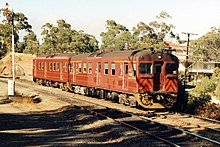
- McKeen railcars , 7 gasoline four-axle vehicles, two from Victorian Railways and five from Queensland Rail imported 1912–1913
- CPH railcar , 37 gasoline four-axle vehicles with wooden body, New South Wales Government Railways (NSWGR) , 1923 ff.
- SAT Brill , South Australian Railways (SAR) narrow-gauge gasoline railcar , 1924–1930
- Creamy Kate , 38 gasoline four-axle vehicle with trailer, NSWGR, 1934
- NSWGR 400 & 500 Class , four-axle diesel multiple units and trailers, 1938
- NSWGR 600 & 700 Class , Diesel Multiple Units , 1949–1950
- SAR 7 & 11 , "Bluebird", 350 four-axle diesel vehicles, 1954–1959
- SAR 300 & 400 "Redhen", 111 diesel four-axle vehicles, 1955–1971
- NSWGR 660 & 760 Class , double multiple units , 1973–1975
- Adelaide 2000 Class (large version 2100 Class) of the city's Adelaide Metro- S-Bahn, 1979/1980
- Adelaide 3000 Class , 1978-1996
- CountryLink Xplorer of the NSW TrainLink company, combinations of two to four, 1993 ff.
- CityRail Endeavor of NSW TrainLink, 1994–1996
- CityRail Hunter of NSW TrainLink, double multiple unit, since 2006
Belgium
- SNCB 551 , built in 1939
- SNCB 552 , built in 1939
- SNCB 553 , from 1971 SNCB 49 , built in 1942
- SNCB 554 , from 1971 SNCB 46 , built 1952
- SNCB 42-43-44-45 , built 1954/1955
- SNCB 40 , built 1957–1961
- SNCB AR 41 , built 1999-2004
Bolivia
- MAN rail buses, 14 multiple units and 14 sidecars, delivered in 1967 and 1977/78 to what was then ENFE
- second generation of Bolivian rail buses 2004
- "Third generation", luxury version, conversion car from an old MAN team
Brazil
- Budd Rail Diesel Car , 29 at RFFSA , built 1949–1962
Bulgaria
China
- Dongfeng (东风), multiple unit, small train restaurant in the motor vehicle, number?, Built in 1958 by CSR Sifang in Qingdao
- NC2, 8 diesel-mechanical quadruple multiple units from MAVÁG , built in 1962
- NYJ1, 11 multiple units, multiple units at both ends, four intermediate cars, Sifang 1998–2001
Denmark
- Y-tog , four-axle: 76 railcars, 23 intermediate cars and 61 control cars, Uerdingen wagon factory 1965–1984
- DSB MF , better known as "IC3", three-segment trains, axles (1A) + (A1) + (1A) + (A1), from ABB Scandia 92 for DSB 1989-1998, others for Sweden and Israel
Finland
- VR series Dm3 and Dm4, 24 four-axle vehicles, 1952–1954
- VR series Dm6 and Dm7 , 212 four-axle model, license replica of the Swedish SJ Y6 - Y8, 1954–1963
- VR series Dm8 and Dm9, 12 multi-part multiple units, 1964–1966
- VR class Dm12 , 16 single multiple units from Škoda Vagonka, 2004–2006
France

- SNCF XM 6000, Micheline , 88 rail vehicles with pneumatic tires, built in 1933
- SNCF XB 1000 , Bugatti autorail ( Bugatti multiple unit), 88 hydromechanical gasoline multiple units, built 1933–1937
- SNCF X 1 u. X 2, Renault VH, 115 diesel multiple units, built 1933–1934
- SNCF XF 1000 and XF 1100 "TAR", 11 express multiple units, 1934–1939
- SNCF X 52000 , 9 "Nez de Cochon" ("Pig Trunk"), built 1938 (photo)
- SNCF X 52100 , 10 "Nez de Cochon" ("Pig Trunk "), built in 1945
- SNCF X 2700 , 10 "RGP2" railcars with control cars, built 1954/1955
- SNCF X 2720 , 18 "RGP1" railcars with control cars, built 1955/1956
- SNCF X 2770 , 10 "RGP1" railcars with control cars, built 1955/1956
- SNCF X 5700 , 10 "Autorail Floirat"
- SNCF X 5600 , 62 "FNC", built 1947–1953
- SNCF X 3600 , 35 built in 1948/1949
- SNCF X 5500 , 51 “Mobylettes”, built 1948–1952
- SNCF X 3700 , 30 built 1949/1950
- SNCF X 5800 , 55 "Mobylettes", built 1953/1954
- SNCF X 3800 , 251 “Picasso” tower railcars, built 1950–1960
- SNCF X 4300 , 151 double railcars, built 1963–1970
- SNCF X 4500 , 126 double railcars, built 1963–1970
- SNCF X 4200 , 10 panorama railcars , 1959
- SNCF X 4630 , 115 double multiple units, built 1971–1977
- SNCF X 4900 , 26 triple railcars, built 1975–1977
- SNCF X 4750 , 47 double railcars, built 1977–1981
- SNCF X 94750 , 8 postal railcars , built 1978/1979
-
Autorail à grande capacité (AGC), three- to four-part low-floor multiple units, in service since 2004, including purely electric two-system trains (series Z 27500) as well
- SNCF X 76500 with diesel drive, 163 trains
- SNCF B 81500 with diesel and direct current drive ( bimodal )
- SNCF B 82500 with diesel, direct and alternating current drive
X 4900 , original
X 2720 in the Gare du Nord station in Paris , 1980
Greece

- AA.71 , 20 four-axle vehicles, plus a sidecar, built by Ferrostaal in 1962
- OSE 520 , 20 four- to five-part multiple units, built jointly by AEG and LEW in 1989/1995
- OSE 620 , 12 double railcars from MAN / Hellenic Shipyards , 1990
- OSE 6501 , 10 three-car multiple units for meter gauge from MAN / Hellenic Shipyards , 1991
- OSE 6521 , 10 double railcars for meter gauge from MAN / Hellenic Shipyards , 1991
- OSE 560 , 17 low-floor double multiple units from Stadler / Bombardier / Hellenic Shipyards , 2003
- OSE 4521 , 10 low-floor double railcars (similar to series 560) for meter gauge from MAN / Hellenic Shipyards , after 2000
- OSE 621 , 15 low-floor double railcars from MAN , developed from 620, 2006
Great Britain
- BR Derby Lightweight , single, double and quadruple motor coaches, BR self-made 1954/1955, Derby Works
- BR Class 101 double multiple unit, 1955–?, From Metro Cammell
- BRl Class 205 , 34 diesel-electric trains with two to three compartment cars, BR self-made 1957–1962, Eastleigh Works
- BR Class 207 , 19 trains, BR Eigenbau 1962 ff., Eastleigh Works
- BR Class 150 , 137 trains, rubber bellows at the ends, 1984–1987 from BREL
- BR Class 156 “Super Sprinter”, 114 double multiple units, diesel-mechanical, large rubber bellows, 1987–1989, Metro Cammell
- BR Class 170 “Turbostar”, 122 trains, diesel-mechanical, built 1998–2005 by ADtranz / Bombardier
- BR Class 220 "Voyager", diesel-electric high-speed train, two drive axles per car, 2001 ff. From Bombardier
Indonesia
- KRD MCDW 300 single multiple unit , mechanical diesel, 1963–1980, Glossing and Schöler GmbH and Ferrostaal
- KRD MCW 301 single multiple unit, diesel mechanical, 1976-now, Nippon Sharyo and INKA
- KRD MCW 302 single multiple unit, (class K2-K3), diesel mechanical (repowering to diesel hydraulics from 1995–1999), 1976-now, Nippon Sharyo and INKA
Iran
- BR Class 141 , 9 double railcars, built in 1984, bought in 2000
- Franz. RTG , five car Turbo trains, Bj. 1976, 5 + 5 buy in 1976 and 2005
- DH4 , 20 four-car trains new from Siemens Austria , 2004
Ireland
Northern Ireland:
Republic of Ireland:
- CIÉ 2600 , 66 railcars, 1952–1957, from AEC
- IE 2700 and 2750, 24 double and two single railcars, since 1998
- IE 2800 , 10 double railcars, since 2000, from Tōkyū
- IE 29000 , 29 four-car multiple units, since 2002, from CAF (Spain)
- IE 22000 , 63 intercity trains of three or six cars, delivery has started, Hyundai + Tōkyū
Israel
- MF / IC3 from Denmark, 10 three-part articulated trains, built 1992–1996
Italy
- FS ALb 25 , gasoline engine, 7560 mm long, 25 seats, 2 railcars and 2 trailers, 1931–1934
- FS ALb 48 , Otto engine, the first 3 four-axle FIAT railcars, 1932
- FS ALn 56 , 110 diesel multiple units, only individual control, built by FIAT and Breda 1933–1938
- FS ALn 556 , diesel railcar for multiple controls , built by FIAT and Breda 1936–1939
- FS ALn 772 "Littorina", (1A) '(A1)', 327 diesel multiple units built 1940–1957 by FIAT and Breda
- FS ALn 990 , B'2 ', 63 built 1950–1953 by FIAT a. a.
- FS ALn 668.1900 , 42 combinable railcars, (1A) '(A1)', built 1975/1976 by FIAT a. a.
- Stadler GTW , diesel-electric version a. a. 12 at the Vinschgau Railway
Japan
- Kidojidoshi , rail bus for private railways, from around 1925
- Kihani 5000 (キ ハ ニ 5000 形), 12 heavy small railcars with 40 hp marine engines, 1929
- Kiha 36900 ( Kiha 41000 ) 136 gasoline railcars , 15.5 m long, 1933–1936
- Kiha 42000 , 62 gasoline railcars , 19 m long, 1935–1937
- Kiha 43000 (キ ハ 43000 系), 2 three-part diesel-electric streamlined multiple units 1937
- Kiha 44000 (キ ハ 44000 系), diesel-electric
- Kiha 45000 (development stages Kiha 10–51 (キ ハ 10,…)), 728 diesel-hydraulic railcars, 1953–1956
- Kiha 55 for short quick connections 1956
- Kiha 58 , "Joyful Train", multiple units for express train service, 1961 ff.
- KiHa 181 , 158 multiple units in groups as express trains 1968–1972, in use until 2010
- KiHa 40-47-48 , 888 railcars, built 1977–1982
- LE 2 , rail buses of the Tarumi Railway and other private railways, 1984–1986
- KiHa 100 , 247 single multiple units 1989–1999
- KiHa 141 , 44 single multiple units 1990
- KiHa 120 , 89 single multiple units 1991–1996
- KiHa 281 , 27 cars for tilting multiple units of 7–8 cars, since 1998
- KiHa 261 , Neige multiple units with 4–6 cars, since 1998
- KiHa E130 , 49 diesel multiple units since 2007
- KiHa 122-KiHa 127 , 19 single or double multiple units since 2009
- kiHa 8500 , Meitetsu Limited Express
Canada
- Budd Rail Diesel Cars
- Bombardier Talent , 3 three-part trains as an O-Train in Ottawa
South Korea
- Korail DEC
- Korail DHC
- Korail NDC
- Korail CDC / RDC
Croatia
- HŽ 7122 , 34 used Swedish Y1 / YF1, built 1979
- HŽ 7121 , 46 Yugoslav 712 + 714 trains, built in 1981
Cuba
- BR 771 / BR 772 , 30 used DR “piglet taxis”, plus 21 control and 3 trailer cars, delivered from 2000
Latvia
- PV DR1A / DR1AM , 40 Soviet DR1A, built in Riga 1973
Lithuania
Malaysia
- KTM Class 26 , 6 four-axle, 1958, Commonwealth Engineering Company , Australia
- KTM Class 27 , 12 four-axle, 1960, Commonwealth Engineering Company, Australia
- KTM Class 28 , 15 four-axle, 1966
Netherlands

- NS 21 , 30 four-axle, built 1953
- NS 61 , 46 diesel multiple units, built 1953
- NS 111 , 42 diesel multiple units, built in 1960
- NS 3100/3200 , 19 single and 31 double railcars , built 1981–1983, later to Noord, Arriva u. Veolia
- NSR 3400 , 23 (+ 21 at Keolis Nederland ) diesel multiple units, built in 1996
- Arriva 10228 –10587, 99 double multiple units, built from 2006, another 10 at Connexxion
- Veolia 200/350 , 16 articulated multiple units from Stadler, built in 2007
Norway
Philippines
- MC railcar 6 three -car trains from Hyundai Rotem
- DRC railcar , 8 single railcars , built 1971–1995 from Victorian Railways
- KiHa 52 from Japan
Poland
- PKP MBxd1 201 to 204 narrow-gauge railcars by Konstal , built 1960–1967
- VT628 (formerly DB vehicles), MAN AG, DUEWAG , 1974–1981
- PKP class MBxd2 narrow-gauge railcars from FAUR ( Bucharest ), built 1984–1986
- SA106 , manufacturer's type PESA 214M , 19 railcars (B'2 ') 2001–2007
- SA 110 (formerly DB vehicles), MAN AG, Waggonfabrik Uerdingen, 1964–1968
- SA133 , manufacturer type PESA 218Mc , 24 articulated trains (B'2'B ') 2006–2012
- SA134 , manufacturer type PESA 218Md , 25 articulated trains (B'2'B ') 2007–2012
- SA137 , manufacturer type Newag 220M , 4 articulated trains (B'2'B '), built 2010 ff.
- SA138 , manufacturer type Newag 221M , 5 articulated trains (B'2'2'B '), built 2010 ff.
Portugal
- Série 0100 da CP , 15 cars (1A) '- (A1)', diesel-hydraulic, built in Sweden in 1948
- Série 0300 da CP , 15 four-axle vehicles, built in 1954/1955 in the Netherlands
- Série 0400 da CP , 19 diesel-hydraulic double railcars , 1965/1966 from the Portuguese Sociedades Reunidas de Fabricações Metálicas
- Série 0600/0650 da CP , 20 double railcars 1979, 5 triple railcars 1989
- Série 0450 da CP , 19 trains (diesel-hydraulic multiple units + trailer), 1999
- Série 0350 da CP , 21 diesel-electric four-axle vehicles, 2000 from the Portuguese Empresa de Manutenção de Equipamento
Romania
- CFR 77 , 40 four-axle rail buses, built 1935–1942, still in service
- CFR 78 , 13 single and 4 double four-axle vehicles, built 1939–1954, still in operation
- CFR 79 , 17 Piglet Taxes, 1960–1977, still in operation
- CFR 76 , 19 used / renovated DB series 614, built 1972, modernized at Remarul 16 February
- CFR 96 , 120 Siemens Desiro, 2003
Sweden
- SJ Y6 - Y8, 378 four-axle diesel railcars, built 1953–1961
- SJ Y3 , diesel-hydraulic multiple unit with double-decker multiple units and control cars, 6 trains built 1966/1977
- SJ Y1 , 100 four-axle diesel multiple units, built 1979–1981
- SJ Y2 , 20 three-part multiple units with large bellows at the ends of the car, identical to the Danish MF (IC 3), built 1989–1996
Serbia
- ŽS 812 , Uerdingen rail buses + license replica, 1955 ff., 9 still in service
- ŽS 710 , 9 used Swedish Y1s, built by FIAT in 1979
- ŽS 711 , 12 diesel multiple units from Metrowagonmasch (RU), 2012
Slovenia
- SŽ 711 , 10 long-distance multiple units, from WMD 1970
- SŽ 813/814 , 48 railcars + 48 sidecars, FIAT u. TVT, 1973
- SŽ 713/715 , 23 railcars + 23 control cars, 1983
Spain
- Series 591 de Renfe , modified Uerdingen rail bus in 60 three, 34 four and 71 two- person combinations with bellows transitions, made up of 1–2 multiple units and 2–0 sidecars by CAF , MMC , SECN , MACOSA and Euskalduna , 1962–1971
- Series 595 de Renfe , Tren automobile engine FIAT (TAF), 50 built 1952–1954
- Series 597 de Renfe , Tren Español Rápido (TER), 60 double railcars built 1964–1966
- Series 592 de RENFE , 70 trains (each 2 diesel-electric multiple units and 1 intermediate car), from Macosa u. Ateinsa , 1981-1984
- Series 593 de Renfe , 63 three-part multiple units, built 1982–1984, from 2004 partly sold to Argentina and Chile
- Series 598 de Renfe , 21 three-part tilting technology multiple units, built by CAF in 2004
- Series 599 de Renfe , three-part multiple units with low-floor intermediate cars, built by CAF since 2008
Sri Lanka
- SLR S8 , 20 diesel-hydraulic trains, max. 80 km / h, Hitachi-Hyundai 1991
- SLR S9 , 15 diesel-electric hybrid trains, max. 100 km / h, 1999 ff. From CSR Sifang in Qingdao , China
- SLR S10 , 15 diesel-electric trains, max. 100 km / h, 2008 from CSR Sifang, China
- SLR S11 , diesel-electric trains for long-distance transport, built by Integral Coach Factory in Chennai , India since 2011
- SLR S10 , diesel-electric luxury trains, max. 120 km / h, since 2012 by CSR Sifang, China
South Korea
- Keha-class rail buses , approximately 41 gasoline railcars made in Japan and Korea
Syria
10 Rotem diesel multiple units, built in 2006
Thailand
- SRT RHN , 38 railcars and 38 trailers, made by Hitachi in 1967
- SRT NKF , 64 railcars and 12 trailers, 1985, Japanese consortium
- SRT APD , 20 railcars and 40 trailers, from Daewoo in 1996
ČSR / ČSSR / Czech Republic and Slovakia
- M 120.1 , 10 petrol rail buses, 1927/1928
- M 120.3 / M 120.4 , 27 petrol tower cars, 1928–1930
- M 130.2 petrol tower car, 63 petrol tower car, 1933–1937
- M 131.1 529 diesel multiple units 1948–1956
- M 152.0 680 diesel multiple units 1973/1975–1982
- ČSD series 809, 28 diesel two-axle vehicles 1976–1982
-
ČD series 814/914 , close coupled combinations of two-axle vehicles with hydromechanical gearbox, partially low-floor reconstruction (conversion) 2005–2012 from railcars of the ČSD series 810 (formerly ČSD M 152.0) and trailer cars of the series 010:
- 212 combinations of two diesel railcars and control cars
- 26 three-way combinations of two diesel multiple units and one intermediate car
- ZSSK series 813, 44 closely coupled two-person combinations of two-axle vehicles without a low-floor section, hydromechanical diesel railcars and control cars, also reko cars from ČSD M 152.0
- ČD series 844 , 31 low-floor hydromechanical diesel multiple units of the Link II type from PESA , B'2'B 'with Jakobs bogie , 2011–2013
Turkey
- TCDD railcars 1–6 , built in 1934 by Škoda
- TCDD railcars 21–26 , built in 1935 by MAN
- MV 5100 , built by MAN in 1942
- RM 3000 , Uerdingen rail buses, bought used in 1898
- MT 5400 , 20 four-axle vehicles, built by SCF Verney
- MT 5600 , 11 four-axle vehicles, built in 1990 by TÜVASAS / FIAT 30 four-axle vehicles
- MT 5700 , 30 four-axle vehicles, built in 1993 ff. By FIAT
- MF 10000 luggage railcar
Tunisia
- Z 431 (standard gauge) / YZ 661 (narrow gauge), 6 + 9 four-axle vehicles, built by Alsthom in 1975
- french AMG 500 , 10 standard gauge multiple units, built by CFD in 2008
Hungary
- Weitzer-De Dion-Bouton railcar , petrol-electric, built from 1903, first series-produced combustion railcar in Europe and one of the first two in the world
- MÁV series Cmot VIIIa and VIIIb , built from 1904 by Ganz & Cie , steam-powered counterpart of the Weitzer-De Dion-Bouton railcar
- MÁV BCmot , internal combustion engine of the Hungarian State Railways, built 1926–1937
- MÁV "Árpád" , comfort rail bus, built in 1934
- MÁV “Hargita” , multiple unit, built 1944–1955
- MÁV Bzmot , identical in construction to ČSD M 152, built from 1975
United States
- McKeen railcars , one of the first two series of combustion railcars in the world
- UP M-10003 - M-10006 , four diesel-electric streamlined twin railcars, made in 1936 by Pullman Standard / General Motors
- Budd Rail Diesel Car , 389 built 1949–1962
- Colorado Railcar double-decker multiple units , 5 double-decker multiple units and 2 double-decker sidecars, built 2005-2008 by Colorado Railcar
- Stadler GTW , 20 diesel multiple units of the New Jersey Transit River Line
USSR / Russia, Ukraine and Belarus
Multiple units:
- DP (ДП) , built 1945 ff. In Hungary, like MÁV "Hargita"
- D (Д) , built 1960–1964 in Hungary, in use until 1984
- D1 (Д1) , built 1964–1988 in Hungary
- DR1 (ДР1) , built 1963 ff. In Russia
- DR1A (ДР1А) 1967–1985 (Rigaer Waggonfabrik)
- D1m (Д1м) , built 1995-2002 (Hungary)
- DEL (ДЭЛ) , built 1996 ff (Ukraine)
- DT1 (ДТ1) , built 2007 ff., Diesel-electric hybrid multiple unit (optional energy supply via overhead line )
Rail buses (Рельсовые Автобусы):
- RA1 (РА1) / Model 731 , four-axle, built since 2004
- RA2 (РА2) , four-axle, aerodynamic, built since 2006
See also
literature
- Rolf Löttgers: The Uerdingen rail bus. Franckh'sche Verlagsbuchhandlung, Stuttgart 1985, ISBN 3-440-05463-2 .
- Raimo Gareis: German diesel locomotives from yesterday. Krone-Verlag, Leichlingen 2001, ISBN 3-933241-36-7 .
- Rainer Zschech: Steam and combustion railcars. Transpress, Berlin 1993, ISBN 3-344-70766-3 .
- Horst J. Obermayer: Railcars - battery powered railcars, steam railcars, electric railcars, combustion railcars. Weltbild-Verlag, Augsburg 1994, DNB 945141912 .
Individual evidence
- ^ C. Guillery: Handbook on motor coaches for railways. Munich / Berlin 1908.
- ↑ Röll: Encyclopedia of Railways → Electric Railways , there Section VII. Automobile Railcars → to b) Petrol, benzene or gasoline-electric railcars
- ↑ www26.us.archive.org: Self-Contained Railway Motor Cars and Locomotives , paragraph SELF-CONTAINED RAILWAY CARS 57–59
- ↑ Henry Pieper's petrol-electric automobile in 1900
- ^ Röll: Arader and Csanáder Railways United Joint Stock Company
- ↑ Railcar from Kiel
- ↑ Eisenbahn Magazin 9/2012, p. 6 ff.
- ^ Profile of the Coche-Motor-Liviano
- ↑ about CML1, the prototype of the CML ( memento of the original from September 2, 2011 in the Internet Archive ) Info: The archive link was automatically inserted and not yet checked. Please check the original and archive link according to the instructions and then remove this notice. (PDF file; 933 kB)
- ↑ Klaus Ecker, Torsten Berndt: 1000 Locomotives: History - Classics - Technology , Naumann & Göbel Verlagsgesellschaft, Cologne 2004, ISBN 3-625-10541-1 , p. 27.
- ↑ Un lujoso ferrobús viaja día por medio a Puerto Quijarro. Bolivian press report on the luxury rail bus (Spanish)
- ↑ Railways of China - Inter City sets and multiple units ( Memento of the original from February 27, 2009 in the Internet Archive ) Info: The archive link has been inserted automatically and has not yet been checked. Please check the original and archive link according to the instructions and then remove this notice.
- ↑ www.flickr.com: Photo of a “pig-trunk” railcar
- ↑ Railfaneurope, OSE withdrawn classes
- ↑ Railfaneurope, OSE stock
- ↑ Railfaneurope, RAI diesel train sets
- ↑ Breakthrough in Japanes Railways (PDF file; 562 kB)
- ↑ Kiha 43000 (キ ハ 43000 系), short portrait (Japanese) with photo
- ↑ Railway Museum in Saitama: Class Kiha 11 ( Memento of the original from September 13, 2016 in the Internet Archive ) Info: The archive link was inserted automatically and has not yet been checked. Please check the original and archive link according to the instructions and then remove this notice.
- ↑ This type of train Tokubetsu Kyūkō (特別 急 行), or Tokkyū (特急) for short , literally "special express trains" (English. Limited express) are express trains with particularly few stops.
- ↑ malayarailway.com
- ↑ Web ferroviaria: Series 591 (ex 300)
- ↑ Listado del Material Ferroviario Español: Renfe - Fuera de servicio - 595 (TAF)
- ↑ Sri Lanka Railways Info Page
- ^ Trains of Turkey
- ↑ trainweb: Colorado Railcar Commuter Car Roster
- ↑ Rail buses come to the Volgograd Oblast for regular service (in Russian) ( Page no longer available , search in web archives ) Info: The link was automatically marked as defective. Please check the link according to the instructions and then remove this notice.
